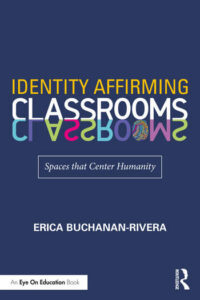Learning Spaces That Affirm Students’ Identities
Identity Affirming Classrooms: Spaces that Center Humanity
By Erica Buchanan-Rivera
(Routledge/Eye On Education,2022 – Learn more)
Reviewed by Katie Durkin

As a first year teacher, I remember the excitement of getting my own classroom. I was ready to decorate, plan lessons, and make decisions about my teaching that I thought would best benefit my students. I was a TEACHER!
I still feel this excitement every August, but this year I have been especially motivated to think more about the space I am creating in my classroom to ensure that my students feel loved and cared for and that their identities are valued – thanks to my time spent with Identity Affirming Classrooms: Spaces that Center Humanity by Dr. Erica Buchanan-Rivera.

The context Buchanan-Rivera presents includes thinking about the role that oppression has played in the design of school and how antiracism is at the heart of creating a classroom that is identity affirming for students.
Understanding equity
The book’s first section ends with a second chapter defining equity for educators, specifically naming the qualities educators who lead for equity will have in their classrooms and schools.
These qualities include educators who are system-focused, who disrupt the status quo, and who embrace criticality of their own work. These equity leaders strive to build a community founded upon accountability and communication (p. 53-54). Buchanan-Rivera provides specific questions to end this first part to help educators grow an equity mindset.
What are identity affirming spaces?
The second part of Identity Affirming Classrooms delves into the components of identity affirming spaces. Chapter 3 starts with a definition of identity and how “deficit thinking and dehumanizing ideologies” threaten students’ multifaceted identities (p. 79).
Most importantly in this chapter, Buchanan-Rivera gives teachers actionable steps they can take to repair harm that has happened within a classroom community. What I found most powerful were direct quotes from students about their own experiences. Buchanan-Rivera specifically highlights student voices to help us understand how the design of classrooms, and the action taken within them, can create identity affirming environments.
Chapter 4 calls on teachers to think about the physical environment of their classroom. When teachers are designing their spaces, including the physical layout of chairs, tables and other pieces of furniture, they should be doing so with identity in mind.
Buchanan-Rivera offers tips that will help teachers think about how to promote collectivism in a classroom through the focus of community. This includes more than thinking about the environment in terms of a physical space but also about the actions of the teachers themselves and how they show support for their students’ identities.
The impact of trauma
The humanity of teaching is one of Buchanan-Rivera’s overarching themes. Chapter 5 dives deeply into this theme, helping educators think about the human work in education, specifically how the roles of trust, connections, positionality, and vulnerability are all part of what it means to be a teacher.
I felt that this chapter was extremely important because it also helps teachers to consider the role trauma has played in shaping students’ lives and their identities. This chapter includes actionable steps educators can take to create a learning community that values, affirms, and cares for each human being in the classroom.
The final chapter of the book concludes with how teachers can leverage student voice through “personalized conferences, listening tours, and the development of student affinity or advocacy groups” to listen and learn from students themselves (p. 143). Buchanan-Rivera’s argument for creating identity affirming classrooms centers on ensuring that students’ humanity comes first. And if we want to understand this humanity, she writes, we need to ask the students.
Resources and actionable steps
The book ends with an epilogue and two appendices. The epilogue concludes the book by bringing attention to Buchanan-Rivera’s fellow scholars who are doing the work to make identity affirming classrooms happen for students. This was a great place for me to find more authors and writers who can help me explore this work further.
The first appendix provides readers with a rating scale to help teachers assess their current classrooms and environments.The second appendix offers actionable steps educators can take if they face resistance when working toward identity affirming spaces.
Mirror work and collective work
What I believe to be the most powerful and arguably most important part of this book is the mirror work and collective work included in each chapter. Buchanan-Rivera makes the point at the beginning of the book that if teachers are to create identity affirming classrooms, they first need to examine themselves, their beliefs, and their identities through mirror work.
Teachers also need to team with similar-minded colleagues to do collective work, where they examine, question, and work towards common goals together. Buchanan-Rivera provides readers with guided questions for mirror and collective work to help them think about the focus in each chapter. This work includes Buchanan-Rivera advocating for readers to keep a journal to track their thinking about the topics covered in the book.
While this book was a quick read being under 200 pages, I would argue that this is a text that should be read more than once and with other people. The work Buchanan-Rivera asks educators to do requires time, reflection, honesty, and hard work. It is not thinking that could be done solely from reading this book.
A must-read for all faculty members
What I enjoyed most about Identity Affirming Classrooms was Buchanan-Rivera’s beautiful blending of scholarship with her own experiences, student interviews, actionable practices, and questions that educators should be considering on a daily basis to learn, relearn, and unlearn. It provides teachers with the background knowledge they need to do this work, alongside actionable practices they could implement in their classroom environments right now. She reminds us that we are in ‘the human business.’ As educators we are called to teach, help, and foster learning in ‘our humans.’
This book is timely, necessary, and a must read for all teachers, coaches, principals, curriculum coordinators, and diversity and Inclusion officers. It’s a call to action. If we want our students to grow, thrive, and learn in our classrooms, we must work towards creating and designing spaces that promote identity development rather than stifle it.
In Chapter 5, Buchanan-Rivera recalls a professional development session where activist and civil rights attorney Fania Davis began the work by asking the audience a question that is a greeting from the Maasai people, a tribe in Kenya and Tanzania: “How are the children?” (p.133).
This question stands upon the foundation of the collective, rather than the individual, and as teachers, we live, thrive and sometimes falter in the collective work we do each day. By thinking about this question day by day, we will continue to love, teach and affirm the humans in our care.
Katie Durkin (@kmerz610) has been teaching English Language Arts to middle school students for over a decade, and currently teaches 7th grade Reading Workshop at Middlebrook School in Wilton, Connecticut. She is a zealous reader of middle grade and young adult books and enjoys sharing her love and passion for reading with her students. In 2022 Katie graduated from Northeastern University with her doctorate in education, where her research examined the impact of classroom libraries on middle school students’ reading engagement. She was the 2020 recipient of the Edwyna Wheadon Postgraduate Training Scholarship from the National Council of Teachers of English.




























